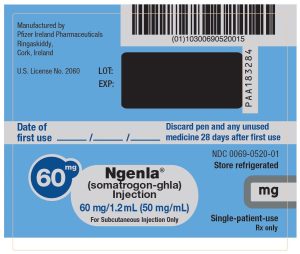Blog
Is Long Acting HGH The Future of Sports Performance?

By Broderick Chavez
Human growth hormone (hGH) is a critical growth-promoting hormone in the human body, composed of a 191-amino-acid single-chain polypeptide produced by somatotropic cells within the anterior pituitary gland. Its primary function is to stimulate the growth of soft tissues and bones and regulate metabolism, growth, and development. Growth hormone deficiency (GHD) is a rare disorder, affecting about 1 in 4,000 to 10,000 children, characterized by insufficient secretion of growth hormone. If left untreated, children with GHD may face persistent growth attenuation, delayed puberty, and various physical and mental health challenges.
History of Human Growth Hormone
First Generation Growth Hormone (1950s-1970s)
The first generation of growth hormone was derived from human cadaveric pituitary glands. In 1958, Maurice Raben successfully extracted it to treat dwarfism in children. However, this method faced significant drawbacks such as limited supply, low purity, and risk of contamination from donor viruses. Due to these issues, the U.S. FDA banned its use in 1985.
Second Generation Growth Hormone (Early-1980s)
The second generation, Met-rhGH, was developed using recombinant DNA technology in Escherichia coli (E. coli). Known as somatrem, this 192-amino-acid growth hormone included an additional methionine residue. Despite the structural addition, its physiological activity was identical to naturally extracted hGH.
Third Generation Growth Hormone (Mid-1980s)
This generation involved recombinant hGH containing 191 amino acids synthesized through gene expression technology in E. coli. However, structural differences made it unsuitable for long-term use.
Fourth Generation Growth Hormone (Late-1980s)
Synthesized via recombinant DNA technology in mammalian cells, the fourth generation of hGH had a structure closer to natural growth hormone. Nonetheless, challenges in cell culture, slow propagation, low yield, and adenovirus contamination limited its widespread use.
Fifth Generation Growth Hormone (1990s)
Genentech’s 1995 production of growth hormone aqueous injection marked the fifth generation. Synthesized through E. coli secretory gene expression technology, it had identical amino acid content, sequence, and protein structure to human pituitary growth hormone. With high biological activity, purity, and absorption rate, this generation became the mainstream market product due to its safety, efficacy, and stability.
Growth Hormone Formats
Short-acting growth hormone formulations come in powder and aqueous forms. Both forms have similar therapeutic effects and safety profiles. However, powder injections offer better stability, while aqueous injections are more convenient to use. Despite their benefits, short-acting preparations require frequent injections, causing inconvenience and reducing patient compliance. Thus, the development of long-acting growth hormone (LAGH) formulations is crucial to enhance patient compliance and therapeutic efficacy.
Development of Long-Acting Growth Hormone (LAGA)
Technologies to increase half-life include depot formulations, PEGylated formulations, pro-drug formulations, non-covalent albumin binding growth hormone, and growth hormone fusion proteins. Currently, only five approved long-acting growth hormone drugs exist: Declage™ (South Korea), Jintrolong® (China), Sogroya® (Novo Nordisk), Skytrofa® (Ascendis Pharma), and Ngenla (Pfizer/OPKO).
Microsphere Technologies
LAGH using microsphere technology adheres unmodified growth hormone to biodegradable microspheres, releasing GH over one month. Despite its early promise, issues such as large microsphere volumes, GH burst release, delayed release, protein aggregation, and production difficulties led to the discontinuation of NutropinDepot in 2004. However, LG Life Sciences’ Declage™ using hyaluronic acid microspheres offers once-weekly dosing and is available in South Korea.
PEGylation
PEGylation involves attaching polyethylene glycol (PEG) to proteins and peptides, increasing their effective volume and solubility, and reducing renal filtration, thus prolonging half-life. Jintrolong® (PEG-rhGH) and Lonapegsomatropin-tcgd (Skytrofa) are notable PEGylated formulations. Skytrofa, approved by the FDA in 2021, releases active somatropin through autocleavage of the TransCon Linker.
Growth Hormone Fusion Protein
Fusion protein technology combines a protein or protein fragment with growth hormone, extending its molecular weight and half-life. Somatrogon (Ngenla), approved in multiple countries, uses C-terminal peptide (CTP) technology to extend half-life, showing significant growth rate improvements in clinical studies.
Albumin Binding Growth Hormone
Binding growth hormone to serum proteins like albumin extends its half-life. Sogroya (Somapacitan), with a single substitution in the peptide backbone and an albumin-binding moiety, is the first FDA-approved LAGH formulation, requiring only once-weekly injections.
Current Thoughts on Real-World Applications in Sports
Performance
My recommendations on dosing and efficacy in sports are currently limited due to the lack of data and real-world use. That said, long-acting growth hormone (LAGH) has a high future potential for sports performance enhancement. If you choose to use LAGH, I suggest using it in conjunction with your standard short-acting variants. In addition, I suggest sticking with PEGylated variants as there may be differences in metabolized standard deviational rates across individuals with microsphere variants and possible immunogenicity issues with fusion protein variants.
Once the technology is fully developed, LAGH could become the best choice for growth hormone in sports performance, akin to the role of Lantus with insulin.
Example Scenarios of Real-World Applications
Assumptions
- Product – Jintrolong 9mg/54iu
- Subject – 100kg bodybuilder
- Recommended best guess dosing – 0.045mg/kg/week
- 100kg -> 4.5mg/week -> 27iu/week for a 100kg bodybuilder
Scenario A – Most Basic
- Jintrolong, 4.5mg once per week, Sunday AM, pre-food
Scenario B – Basic +Daily
- Jintrolong, 4.5mg once per week, Sunday AM, pre-food
- Lantus, 10iu/day, Monday-Friday AM, with first meal
Scenario C – DailyJintrolong, 4.5mg once per week, Sunday AM, pre-food
- Lantus, 10iu/day, Monday-Friday AM, with first meal
- HGH, 1-3iu/day, Monday-Friday PM, pre-bed
Scenario D – Daily Full Spectrum
- Jintrolong, 4.5mg once per week, Sunday AM, pre-food
- Lantus, 10iu/day, Monday-Friday AM, with first meal
- HGH, 1-3iu/day, Monday-Friday PM, pre-bed
- Rapid Insulin, 5iu 3x/day (15iu total/day), Monday-Friday, with first, middle, and final meals
Generic Pre-Course Recommendations
Begin 7-14 prior to peptide therapy (continuing for the duration)
- Test blood glucose every morning for 7-14 days, first thing AM, pre-food and activity
- Metformin, 500mg/day
- Chromium Picolinate, 2mcg/kg of body weight, pre-bed
